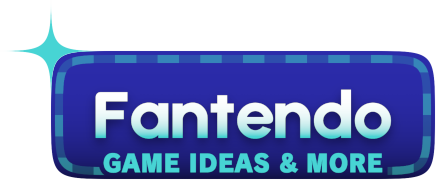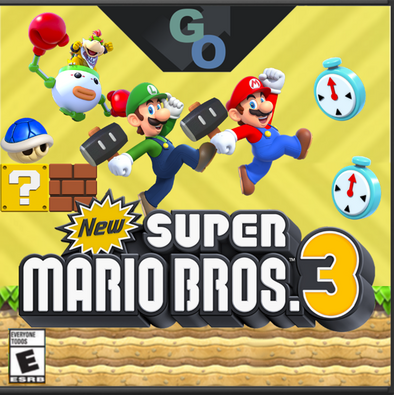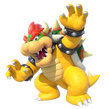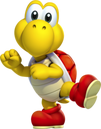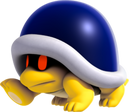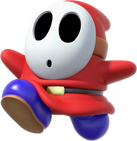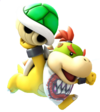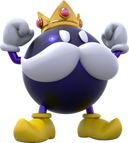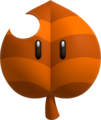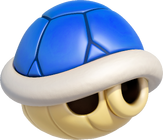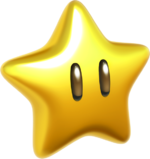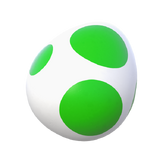New Super Mario Bros. 3 is a side-scrolling 2.5D action-adventure platform game for the Nintendo DSGo and it was first released in Japan in June 17 2024. It is the nineteenth title in the Super Mario series of games and is the seventh title in the New Super Mario Bros line after New Super Mario Bros. U Deluxe for the Nintendo Switch. As a direct sequel to New Super Mario Bros. for the Nintendo DS and New Super Mario Bros. 2 for the Nintendo 3DS, this instalment follows in the footsteps of those games, utilizing the touch screen on the DSGo to spawn items from the inventory box and to see how far you have gotten in the level, while also being an indirect follow up to New Super Mario Bros. U. The game's story is partly based on the story of New Super Mario Bros. U, where Bowser airship's arm throws Mario and Luigi out of the castle, far away. The differences here however are that it's on the Koopa Clown Car, the brothers land in Bowser's Castle, starting from there as the first world in the game and they progress onwards from a reversal of the worlds that were established in the previous instalments. Much like New Super Mario Bros. 2, the game's main focus heavily relies around coins, with the primary goal being to collect one million. The game allows for two-player co-op, allowing a second character with another DSGo to play as Luigi or Mario.
Story[]
Despite being based off of New Super Mario Bros. U, the story doesn't tie in with that game, it takes place after the events of New Super Mario Bros. 2.
During the story, standing on the balcony of Peach's Castle, Mario and Luigi are looking out at the sky, having a cup of tea. Their moment of silence and peace is interrupted by the sight of the Koopa Clown Car , the bros stand up preparing for a fight, but are caught off guard by the sight of a mechanical arm, which grabs them, swinging them into the air, landing into Bowser's Castle. Their goal is to return home.
Arriving at Peach's Castle, the brothers are put into a life or death scenario where they're up against Bowser Junior and Bowser. One of the duo has to step on the ! Switch behind them making the bridge collapse and sending the father and son to their doom. With the structure of the castle collapsing in the process, the brothers attempt to break Princess Peach out of the cage she's locked in, but it gets pulled upwards with the brothers holding on for dear life. The Koopalings are pulling the cage to the top floor of the castle, smashing through the floors carelessly, trying to knock one of them off. Reaching the top of the building, all seven of the Koopalings engage in a fight with the duo, losing in the process. The brothers escape with Peach in the Koopa Clown Car to see the destruction of the castle.
The credits is a picture book full of photos taken on the levels in the game on the top screen of the DSGo, while on the bottom screen, is a montage of the reconstruction of the castle.
Characters[]
Gameplay[]
The basic gameplay is very similar to the previous New Super Mario Bros. games, where the structure of the levels is basically point A, point B and then point C. Unlike New Super Mario Bros. 2 on the Nintendo 3DS, which played like a collectathon as the objective was collecting coins, New Super Mario Bros. 3 goes back to playing like a 2D platformer. The objective of this game however, is the time it takes to beat a level, with the option to replay the level under 100 seconds. Beating every single level under 100 seconds, unlocks a set of stages to play in Mario VS. Luigi, the fourth star on the save file and a minigame mode akin to Super Mario 64 DS.
Like New Super Mario Bros., the bottom screen displays a map, showing the length of the level and where the player is, as well as showing the Star Coins collected, points total, number of extra lives, and also providing an item storage. It also shows the total number of collected coins in a stage, with the record number displayed next to it. There are twelve worlds: nine main worlds, and three special worlds. Each world contains a different number of levels, including Ghost Houses, Fortresses and Castles. Different sets of bosses are found in the middle and end of each world.
A two-player co-op mode is also available, in which a second player plays as Luigi accompanying Mario in the single-player game; both players may select which character they would like to be, however. This mode can only be played with two Nintendo DSGo consoles and two game cards. The gameplay is not much different from the single player, although in co-op coins and lives are shared between the two players, with each collected coin or extra life earned (though not collected) counting as two. Each player also has their own item storage, which can be accessed at any point. Several mechanics from the New Super Mario Bros. Wii multiplayer, such as the bubble and item boxes giving two items, are retained for this mode. In addition, the camera only focuses on one player at a time (denoted by a colored arrow above their character; red for Mario and green for Luigi), and can be changed during the level by ground-pounding the player currently in control, if the other player enters another section of the level first, or if the player of focus loses a life or enters a bubble.
Mario VS. Luigi []
The implementation of two player co-op reintroduces the Mario VS Luigi mode, which was originally seen in the original New Super Mario Bros, where two people playing as either Mario or Luigi fight for the highest amount of Power Stars. Those stars appearing at random in the side-scrolling stages. The end of each of those stages is their beginning (the stages are looped). When Mario or Luigi are hit by enemies, fall down or hit each other, they lose a star, which can then be again collected by any of the brothers. The first brother to reach the previously set amount of stars wins the game. When a brother collects eight coins, a random power up will appear (Mushroom, Fire Flower, Blue Shell, Mini Mushroom, Mega Mushroom, Starman, Turnip). When a brother has a certain amount of victories, he wins the match.
Coin Rush[]
Also featured in New Super Mario Bros. 2 was Coin Rush mode, a time attack-esque mode that challenges the player to collect as many coins as they can in three randomly selected single-player levels without losing a life. The difference being that there aren't any packs of levels to choose from and instead, levels can be selected manually, or at random through a roulette.
Enemies[]
Old[]
New[]
Bosses[]
Tower Bosses[]
Castle Bosses[]
Items[]
Stage Props[]
Power Ups[]
Worlds[]
| Name | Picture | Description |
|---|---|---|
| Bowser's Castle | 
|
The starting location of New Super Mario Bros. 3, filled with a gauntlet of enemies to destroy. The main boss being Bowser himself. |
| Nimbus Roadway | 
|
The cloudy world of New Super Mario Bros. 3, littered with Lumas on a vacation from space. The boss is Lakithunder. |
| Mount Donuts | 
|
The ancient cliffside world of New Super Mario Bros. 3, known for it's desertous and deep foodstuffs, the boss is Boss Sumo Bro. |
| Grumpy Glacier | 
|
The freezeflame snow world of New Super Mario Bros. 3. A temperature mixture of hot and cold, hence the name of the world. The boss is Madame Broode. |
| Jamsy Jungle | 
|
The spider infested jungle world of New Super Mario Bros. 3. Located outside of Grumpy Glacier, the hot savana part of that world has affected this jungle, leading to some serious forest fires. The boss is Petey Piranha. |
| Coral Paradise | 
|
The beach world of New Super Mario Bros. 3. Located within the outskirts of Jamsy Jungle, lies the sandy parts of said world, littered with Piantas on vacation from Delfino Island. The boss is King Bob-omb |
| Ugly Astec | 
|
The desert world of New Super Mario Bros. 3. The main entrance world to Toad Town's gateway, a deserted mine field of sand and sandstorms. The boss is Dry Bowser |
|
Toad Town |

|
The town world of New Super Mario Bros. 3. The outskirts of Peach's Castle, which have been set ablaze by the doings of the Koopalings. The boss is The Broodals Quartet |
| Peach's Castle | 
|
The final world of New Super Mario Bros. 3. What used to be a sweet little home for the Princess of the Mushroom Kingdom, has become a hostage building, about to set on fire from the blazes of Toad Town. The final bosses are the Bowser combo and the Koopalings. |
Development[]
With the launch of the Nintendo DSGo, Nintendo EPD considered developing a 2D Mario game for the system. The team had to decide between making an original title or another New Super Mario Bros game. With the hardware being partally based on a small Iphone5, they eventually settled on making a brand new New Super Mario Bros game, following in the same vien as the first game in the series, while shaking it up a bit.
When developing New Super Mario Bros. 3, the developers decided to bring over the more favourable ideas from the original and the one on the Nintendo 3DS in order to make it replayable, whilst taking inspiration from the plot summary of New Super Mario Bros. U. Shaking up the world design by going through a reversal was an idea that Takashi Tezuka and Toshihiko Nakago came up with early in development as they felt that it would give off a more cinematic feel for the game, raising the stakes much higher than they were in New Super Mario Bros. U.
References to other games[]
- New Super Mario Bros U: As an indirect follow-up to this game, it follows the same structure in the story, with some differences. The Boost Star, as a power up returns and Boss Sumo Bro returns as a main boss.
- New Super Mario Bros: As another direct sequel to this game, Mario's Mini and Mega forms return along with the Blue Shell as a powerup. This game's remix of the Super Mario Bros. theme is used during the Dash Mario stages, as well as the Mega Mushroom theme, the volcano theme, castle theme, beach theme and desert theme. The Mario VS Luigi mode is brought back from this game, working like it did before
- New Super Mario Bros 2: As a direct sequel to this game, the Gold Flower returns as a power up and the Coin Rush mode returns.
